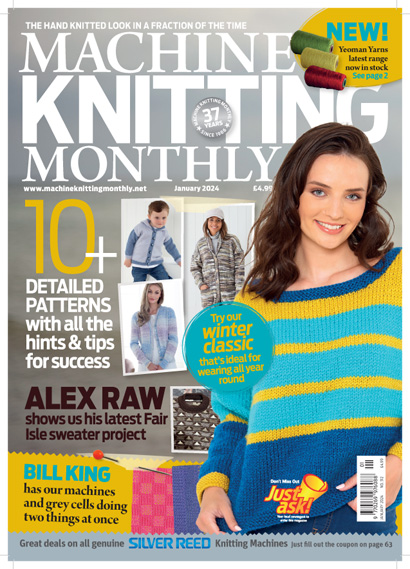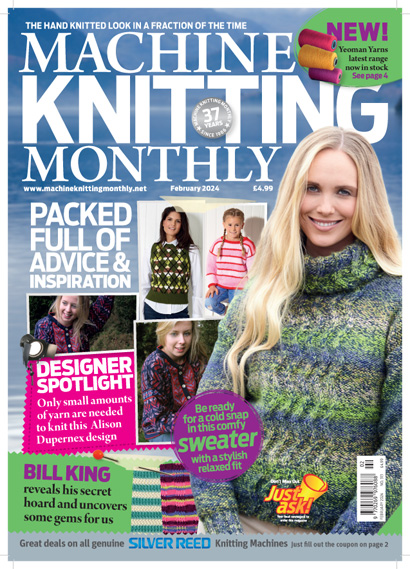
Dear Readers
As you’ll read on Page 10, Doug Bristow’s funeral has taken place and my sadness at his passing has been replaced by many happy memories. A year or two after I first published the magazine, Doug and Brenda opened Heathercraft Knitting Machine Centre and their shop has been running for over 35 years. At that time, machine knitting was one of the most popular crafts. There were a huge number of small shows and large exhibitions up and down the country. Anyone selling anything to do with machine knitting loaded up their vehicle and set off for a day trip or a five-day marathon.
In those heady days, exhibitors soon got to know one another. I was in a small group that included Nick at Uppingham Yarns, John at B Hague & Co, Chris at Riverside Yarns and designer Jan Wright. Doug and Brenda brought up an ‘honourable rear’, as timekeeping was never their forte! After setting up the day before the show, we’d all stay in a Premier Inn (or similar!) and enjoy an evening meal together. It was one such time when the five of us learned that Doug and Brenda had met at a flying club. It was the end of the 60s and Doug would take her on trips when she got her pilot’s licence in 1971. Love blossomed… as they say! The couple were married in September 1973, so were able to celebrate their 50th wedding anniversary just before Doug’s passing in October. As their older son Alan said at the funeral, Doug was: “Curious, eclectic, gregarious and intelligent. He was full of mirth, quips and silliness. He was also patient, persistent and always responsible”. Alan describes perfectly the man I knew.
Doug’s funeral was one of those rare events, conducted by someone who actually knew him. For the first time I’ve seen, the coffin remained in view until the very end of the service, not enclosed in faded curtains and lowered on squeaking apparatus crying out for a drop of oil. Everyone was of an age to remember the comedy song written by Eric Idle for Monty Python. Courtesy of the Order of Service, there were all the words. The vicar whistled and joined in the chorus. Toes tapped, hips swayed with the beat and everyone smiled as they sang:-
If life seems jolly rotten
There’s something you’ve forgotten
And that’s to laugh and smile and dance and sing
When you’re feeling in the dumps
Don’t be silly chumps
Just purse your lips and whistle, that’s the thing
And
Always look on the bright side of life
Always look on the right side of life
The video recording of the service is on Heathercraft’s website (https://www.heathercraft.co.uk/)and Brenda tells me she’ll leave it there for a little longer. It’s also her intention to keep the shop open. This lovely man fixed our machines and sorted out our wonky attachments. He found genuine sponge bars, needles and spares for Heathercraft, as well as many other shops in the country. He was also the best-ever dad and husband and a great friend to all those who really knew him. You have our love and support, Brenda, as we send our sincere condolences to you, Alan and Peter, your worldwide family and many friends. Rest in peace, Doug; you were one in a million.
NEXT ISSUE February 2024
Subscription copies sent out Thursday 4th January
On sale Thursday 11th January
Ask your newsagent to reserve a copy or order a subscription NOW!




